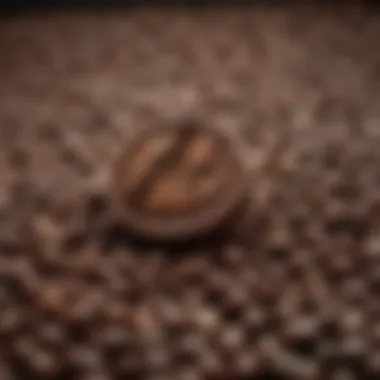Discover the Best Grinder Coffee Makers Today


Intro
Selecting the right grinder coffee maker can significantly elevate your coffee experience. The nuances of grinding play a crucial role in the flavor and texture of your brew. With numerous models on the market, making an informed choice can be daunting. This guide aims to simplify that process by dissecting the standout features of top grinder coffee makers. Understanding the impact of grinding can transform a simple cup of coffee into an artful experience.
We'll dive into various aspects such as design inspiration, practical tips, and other important considerations. Whether you are an occasional drinker or a coffee aficionado, this guide provides the necessary insights to help you make the best decision. Below, we explore how design influences functionality and brewing results.
Preamble to Grinder Coffee Makers
In the realm of coffee preparation, the grinder holds a pivotal role. It acts as the bridge between the raw coffee bean and the final beverage, influencing both flavor and aroma. Understanding the dynamics of grinder coffee makers is essential for anyone seeking to enhance their home brewing experience. This section outlines the key elements that define grinders and their relevance to crafting the perfect cup of coffee, particularly for discerning homeowners and those who appreciate quality.
What is a Grinder Coffee Maker?
A grinder coffee maker refers to a device that integrates grinding and brewing processes. These machines vary in complexity and functionality but generally allow users to grind coffee beans on demand. This feature ensures that the freshness of the coffee is maintained until the moment it is brewed.
Grinder coffee makers may come equipped with either burr or blade grinders, influencing the texture of the grind. Burr grinders provide a consistent particle size, while blade grinders may result in uneven grinds. Consumers often need to balance convenience, grind quality, and cost when choosing a suitable coffee maker.
The Importance of Freshly Ground Coffee
Freshly ground coffee is known for its rich flavors and aromatic qualities. According to research, coffee begins to lose its flavor within minutes of grinding. The oils and compounds that contribute to aroma dissipate quickly, making instant pre-ground coffee less desirable.
By grinding whole beans immediately before brewing, users maximize the flavor potential of their coffee. The freshly ground coffee allows individuals to experience nuanced notes in their beverage, regardless of the brewing method selected.
Moreover, the grind size can be adjusted based on the brewing technique, whether it be espresso, drip, or French press. This ability to customize is vital for enthusiasts who wish to explore various coffee profiles.
"Freshly ground coffee is not just a preference; it is a necessity for those who seek true quality in their daily brews."
Key Features of Grinder Coffee Makers
When searching for the right grinder coffee maker, it is crucial to understand the core features that differentiate models. These features directly impact performance, user satisfaction, and the quality of coffee produced. Identifying these elements can help consumers make informed decisions that align with their preferences and brewing habits.
Types of Grinders: Burr vs. Blade
Burr Grinders
Burr grinders are designed to crush coffee beans between two revolving abrasive surfaces. This method allows for a more consistent grind size compared to blade grinders. Because of their design, burr grinders achieve uniformity, which is essential for optimal extraction and flavor development. They are often regarded as preferable by coffee enthusiasts due to their ability to create fine, medium, or coarse grinds depending on the user’s needs.
The key characteristic of burr grinders is that they can be adjusted to obtain different grind settings. This adjustability offers the flexibility required for various brewing methods, from espresso to French press. The unique feature of burr grinders is their slow grinding process, which minimizes heat build-up, preserving the coffee’s delicate flavors and aromas. However, some disadvantages include their higher cost and potentially more complicated cleaning processes.
Blade Grinders
Blade grinders use a metal blade that spins at high speed to chop the coffee beans. While blade grinders are generally less expensive, they tend to produce an inconsistent grind size. This inconsistency can lead to uneven extraction during brewing, resulting in a less desirable flavor profile.
The primary characteristic of blade grinders is their simplicity and affordability. They are a popular choice for those who are just starting their coffee journey and are looking for a budget-friendly option. The unique feature of these grinders is their ability to grind beans quickly, making them convenient for users who may be short on time. However, the significant disadvantage is the heat and friction generated during grinding, which can negatively affect the taste of the coffee.
Grind Settings and Customization
The grind settings feature allows users to customize their coffee experience. Different brewing methods require various grind sizes. Understanding the relationship between grind size and extraction can greatly enhance the overall flavor. For instance, espresso requires a much finer grind compared to a French press which benefits from a coarser consistency. Many grinder coffee makers offer a range of settings that allow for this customization, making it easier for users to experiment and find their preferred brew.
Size and Capacity Considerations
The size and capacity of a grinder are significant aspects to keep in mind. For individuals or small households, a compact grinder may be sufficient. Conversely, larger families or those who frequently entertain guests may require a model with larger capacity. A grinder's size can also affect storage and counter space in the kitchen. Therefore, it is important to balance your grinding needs with the available space in your home.
Ease of Cleaning and Maintenance


Keeping a coffee grinder clean is essential for maintaining flavor integrity. Some models are designed for easy disassembly, allowing for quick and thorough cleaning. Grinders that accumulate coffee oils can have a detrimental effect on the taste of future brews. Thus, it is beneficial to choose a grinder that offers simple maintenance procedures and removable parts for ensuring cleanliness. Regular upkeep can enhance the lifespan of the appliance as well as the quality of the coffee produced.
Top Brands in Grinder Coffee Makers
In the realm of grinder coffee makers, brand reputation plays a crucial role. Established brands often showcase reliability, innovative technology, and dedicated customer service. They set benchmarks in terms of performance and quality. Choosing a reputable brand can significantly impact your experience, from user satisfaction to the coffee brewing quality. Let's discuss several leading brands that have made notable contributions in this domain.
Breville
Breville is known for its sleek designs and advanced features. Their grinder coffee makers come equipped with precision grinders that enhance flavor extraction. Many models feature setting adjustments for various brewing methods, catering to both espresso lovers and French press enthusiasts. The intuitive interface is user-friendly, allowing novices to easily navigate through different grind sizes. Additionally, Breville products often include built-in scales, ensuring consistency in coffee-to-water ratios.
Baratza
Baratza specializes in high-quality grinders, emphasizing functionality and durability. Their devices are particularly well-received among coffee aficionados. Known for offering a wide range of grind settings, Baratza grinders allow for extensive customization, which is essential for achieving desired coffee characteristics. They also prioritize ease of maintenance, with many models built for straightforward cleaning. Industry professionals frequently recommend Baratza for those looking to balance quality and affordability.
Capresso
Capresso focuses on merging technology with style. Their grinder coffee makers often feature multiple grind settings to suit different preferences and serving sizes. The brand is synonymous with efficiency and performance. Many Capresso models are compact and come with intuitive controls that make them suitable for various users, from beginners to experienced baristas. Their affordable yet effective designs have made them a popular choice among home users.
Hario
Hario emphasizes craftsmanship and tradition in coffee-making. Known primarily for their manual grinders, they produce products that allow users to enjoy a hands-on experience. The appeal of Hario lies in its commitment to high-quality materials, resulting in durable and aesthetically pleasing designs. Their grinders are often a favorite among those who appreciate the art of coffee. Using a Hario grinder can give you a deeper connection to the coffee process, offering a unique brewing experience.
Krups
Krups combines modern technology with user-friendly designs. Their grinder coffee makers offer a range of options suitable for various brewing styles. Emphasizing versatility, Krups products often include programmable features that allow users to set grind times and adjust quantities. They are generally affordable while delivering consistent performance. This brand tends to attract those who want reliability without an extravagant investment.
In summary, choosing among these top brands can influence not only the ease of use but also the overall coffee experience. Each brand has its unique offerings and strengths, catering to diverse preferences and needs.
Evaluating Performance
When it comes to grinder coffee makers, evaluating performance is crucial. A grinder's performance affects the taste, aroma, and overall enjoyment of your coffee. Understanding the specific aspects of performance can help users make a more informed choice when selecting a grinder coffee maker. In this section, we will examine three main parameters: grinding consistency, time efficiency, and noise levels during operation.
Grinding Consistency
Grinding consistency refers to the uniformity of the coffee grind size produced by the grinder. This consistency is an essential factor influencing extraction during brewing. If the grind size varies greatly, some particles over-extract while others under-extract, leading to a skewed flavor profile.
For instance, a grinder that produces mostly fine grounds with a few larger particles may result in a bitter or sour cup. On the other hand, a consistent grind allows for balanced extraction, ensuring that all flavors are represented. Burr grinders, in particular, excel in providing consistent grind sizes compared to blade grinders.
A few key points about grinding consistency:
- Flavor Impact: Consistent grind promotes even extraction, enhancing the overall flavor profile.
- Brew Method Compatibility: Different brewing methods require specific grind sizes, so consistency is vital for versatility.
- Coffee Type: Low-quality grinds can spoil premium coffee beans, losing their intended flavors.
Time Efficiency in Grinding
Time efficiency addresses how quickly a grinder can produce the desired grind. For most coffee enthusiasts, quick grinding is a benefit, especially for busy mornings. However, it is crucial not to sacrifice quality for speed.
Many modern grinders have optimized their mechanisms to provide faster grinding without compromising consistency. Some key aspects to consider include:
- Motor Power: More powerful motors can grind quickly without overheating the beans, which affects flavor.
- Batch Size: Larger hoppers allow you to grind a bigger quantity of coffee in one go.
- Heat Maintenance: Quick grinding preserves the beans' properties, ensuring each cup remains flavorful.
Noise Levels During Operation
Noise levels during grinding might seem trivial, but they can be essential. A noisy grinder can disrupt early-morning routines or late-night coffees. Understanding how various grinders operate in terms of sound can make a significant difference.


Here are some factors to keep in mind about noise:
- Grinder Type: Generally, burr grinders operate more quietly than blade grinders due to their grinding methods.
- Design Features: Some models incorporate sound-dampening materials or technology to minimize noise.
- User Environment: Consider the setting where the grinder will be used. A quieter model may be beneficial in open-plan homes or apartments.
"Choosing the right grinder coffee maker involves careful consideration of performance metrics like grinding consistency, efficiency, and noise that can impact your overall coffee experience."
In summary, evaluating performance helps potential buyers make informed decisions. A grinder's consistency, speed, and noise levels all contribute to the user's overall coffee-making experience. By paying attention to these factors, users can ensure they select a grinder that meets their needs and enhances their daily coffee ritual.
Design Considerations
In the realm of grinder coffee makers, design considerations wield significant weight. The aesthetics of a coffee maker can enhance the overall ambience of your kitchen, but it goes beyond just looking good. A well-designed grinder not only complements kitchen decor but also optimizes functionality and user experience.
Aesthetic appeal plays a crucial role in consumer preference. When multiple options are available, buyers often gravitate toward models that are visually appealing. As a homeowner or interior design enthusiast, choosing a grinder that integrates seamlessly into your kitchen's design can create a more cohesive look. Stainless steel, bold colors, and sleek lines can elevate the kitchen's visual note.
To this end, consider how the grinder will fit into your kitchen layout. If space is limited, look for compact models that do not sacrifice performance for size. A thoughtful and attractive design can make the grinder a focal point without becoming overwhelming.
"Design is not just what it looks like and feels like. Design is how it works." - Steve Jobs
Another important element is usability. A grinder that is intuitive in design can streamline the coffee-making process. This brings us to the user interface and controls.
Aesthetic Appeal and Kitchen Integration
The visual aspect of a grinder coffee maker is perhaps its most immediate attribute. A good design can compel customers to choose one model over another. Look for features like a sleek finish, compact size, and contemporary shapes that resonate with your personal style.
Highlighting the machine as an aesthetic component of your kitchen can enhance the overall experience of brewing coffee. Hence, when choosing your grinder, think about how its style will work with existing appliances and decor. A bright or unique design may energize the space, while a minimalist model can bring a touch of elegance.
User Interface and Controls
User interface and controls directly impact the coffee-making experience. A well-designed interface should have clear labels and intuitive functions. Controls that are easy to reach and operate help users navigate their grinding options without confusion, which is especially essential in busy morning routines.
Look for grinders that offer simple buttons or dials. Some models may add a digital display to inform users of grind settings and remaining grinding time. An effective user interface contributes to the overall satisfaction of making coffee.
In summary, thoughtful design considerations in grinder coffee makers go beyond aesthetics to enhance functionality and ease of use. Selecting the right model not only improves the coffee experience but also enriches the kitchen environment.
Cost Analysis
In this section, we will explore the cost analysis of grinder coffee makers. Understanding the price dynamics and value proposition of these machines is crucial for making an informed decision. A comprehensive cost analysis encompasses initial purchase price, potential long-term savings, and the overall value compared to coffee quality.
Price Range of Grinder Coffee Makers
When shopping for a grinder coffee maker, it is essential to consider the price range. Grinder coffee makers can vary vastly in cost depending on their build quality and functionalities. You may find basic blade grinders priced around $20 to $50. These models are a good starting point for newcomers but limit customization and consistency.
Burr grinders, which are superior in terms of grind quality, typically enter the range of $100 to $300. For high-end models, often favored by coffee aficionados, the prices can exceed $300 or even reach up to $1,000 for commercial-grade machines. These machines offer better grinding consistency, enhanced features like programmable settings, and sometimes even built-in scales.
- Budget Range (Up to $50): Basic functionality, easy to use, limited grind settings.
- Mid-Range ($100 - $300): Good consistency, more grind settings, suitable for most homebrewers.
- High-End ($300 and above): Exceptional grind quality, durable, ideal for serious enthusiasts or commercial use.
Each price tier has its advantages and disadvantages. It is vital to align your budget with your coffee needs and preferences.
Long-term Investment vs. Immediate Cost
Evaluating whether to spend more upfront or go for a cheaper option also requires careful analysis of long-term investments. A higher-priced grinder coffee maker might seem like a significant initial expense, but it often results in better grind consistency, which translates to better tasting coffee. Over time, this can lead to savings on coffee beans, as you may require fewer beans to achieve the desired flavor profile.
Conversely, a lower-cost option may save you money initially, but could cause frustration over time due to inconsistent grind sizes. Inconsistent grind can negatively impact the extraction process when brewing coffee, often leading to poorer results. Therefore, while it may be tempting to opt for the cheaper model, consider the total cost of ownership.


Moreover, high-quality grinders tend to last longer and require fewer repairs, adding to their overall value. It's essential to weigh immediate savings against potential frustrations and costs incurred later due to substandard equipment.
Setting Up and Using a Grinder Coffee Maker
Setting up and using a grinder coffee maker is a crucial step to enhancing your daily coffee experience. This process can dramatically influence the flavor, strength, and overall enjoyment of your coffee, making it essential for both novice and experienced users alike. Understanding the setup and usage mechanics not only ensures optimal performance of the coffee maker but also maximizes the flavor potential of each coffee bean.
Initial Setup Process
The initial setup process is the first step to enjoying freshly ground coffee at home. First, you must choose an appropriate location for your grinder coffee maker. Look for a flat surface, preferably near an electrical outlet and away from direct sunlight. This can help maintain the grinder's integrity and ensure that you have a functional workspace.
Next, unpack the coffee maker carefully, ensuring you don’t lose or damage any parts. Most grinder coffee makers come with the grinder unit, a coffee container, and a scoop or measuring tool. You should wash the removable parts with warm soapy water to eliminate any residue from manufacturing or storage. Rinse and dry them completely before reassembling.
Once cleaned, plug in the coffee maker and ensure it is properly connected. Depending on your model, you may need to calibrate the grinder settings. Check the user manual for specifications on how to adjust grind settings and select grind size that suits your preferences.
Tips for Optimal Grinding
To achieve the best flavor extraction from your coffee, there are several tips to consider:
- Use Fresh Beans: Always opt for freshly roasted beans. They contain the most flavor and aroma, leading to an enhanced coffee experience.
- Match the Grind Size to Brewing Method: Different methods require different grind sizes. For example, a coarse grind is ideal for French press, while fine grind works best for espresso. Adjust the settings on your grinder accordingly.
- Grind Just Before Brewing: Grinding coffee beans just before brewing allows the natural oils and flavors to be at their peak. This leads to a flavorful and aromatic cup of coffee.
- Regular Cleaning: Regularly clean your grinder to prevent oils and residues from building up. This ensures that each brew maintains its intended flavor profile.
- Experiment and Adjust: Taste is subjective, so don’t hesitate to experiment with different settings and bean types. This will help you find your perfect cup.
"The key to a great cup of coffee lies in the grinding process. Invest time in getting it right."
Setting up and using a grinder coffee maker properly establishes a foundation for your coffee brewing routine. With attention to detail, an understanding of your equipment, and a commitment to quality beans, you can transform a simple cup of coffee into an extraordinary experience.
Frequently Asked Questions
In this section, we aim to demystify common inquiries surrounding grinder coffee makers. Addressing frequently asked questions enhances the article's overall value by providing clarity to readers who may feel overwhelmed by the choices available. By tackling these questions, we not only simplify the decision-making process but also empower readers to enjoy their coffee journey more fully.
How to Choose the Right Grinder Coffee Maker?
Selecting the appropriate grinder coffee maker requires considering various factors to match personal preferences and brewing styles. Key aspects include type of grinder, grind settings, and budget.
- Type of Grinder: Determine whether a burr or blade grinder better suits your needs. Burr grinders offer better consistency, while blade grinders are typically less expensive and easier to find.
- Grind Settings: Different coffee types require different grind sizes. A grinder that allows for multiple settings gives greater versatility, particularly if you enjoy experimenting.
- Budget: Grinding equipment ranges significantly in price. Setting a clear budget before shopping helps streamline options.
By carefully evaluating these elements, one can make a more informed choice, ensuring a satisfying brewing experience.
What is the Best Grind Size for Different Coffee Types?
Understanding the ideal grind size for various coffee types is crucial for brewing the perfect cup. Coffee requires specific grind sizes to optimize extraction. Here’s a quick guide:
- Espresso: Requires a fine grind to ensure optimal extraction under pressure.
- Drip Coffee: A medium grind works best, allowing for a balanced flavor profile without over-extraction.
- French Press: A coarse grind is preferred for a full-bodied brew, minimizing clogging and bitterness.
- Cold Brew: Similar to French Press, use a very coarse grind to promote smoothness in cold waters.
Adjusting your grind size can significantly affect the taste and quality of your coffee, making it an important consideration in the brewing process.
Ending
The conclusion is a critical segment of the article, as it synthesizes the insights gained from exploring grinder coffee makers. This section serves multiple purposes. First, it emphasizes the essential factors that potential buyers should understand. Not only does it reinforce the significance of having the right grinder coffee maker, but it also encourages readers to consider how these machines can enhance their coffee experience at home.
Summarizing Key Takeaways
In essence, several key elements have emerged from our examination:
- Quality Matters: The type of grinder—whether burr or blade—significantly affects the flavor and aroma of coffee. Burr grinders are generally preferred for their consistency.
- Customizable Grinding: The ability to adjust grind settings allows for a tailored brewing process, catering to individual taste preferences and different coffee types.
- Design Integration: The aesthetics and functionality of a grinder coffee maker should complement kitchen decor and ease of use.
- Investment and Longevity: Understanding the cost-effectiveness of various models can lead to better decisions, aligning with both short-term budgets and long-term coffee enjoyment.
Final Thoughts on Selecting a Grinder Coffee Maker
When it comes to selecting a grinder coffee maker, a thoughtful approach is paramount. Prospective buyers should assess several aspects:
- Personal Preference: Determine how often coffee will be made and the types of coffee loved. This can heavily influence the decision.
- Space Availability: Consider kitchen space when choosing a model. Some grinders can be large; others more compact and easier to store.
- Maintenance Needs: Evaluate how easy it is to clean and maintain the grinder, as this impacts long-term usability.
The journey towards achieving the perfect cup of coffee starts with an informed choice. Investing time and thought into selecting the right grinder coffee maker not just elevates the coffee experience, but also ensures satisfaction with every sip. As you embark on this choice, keep your specific needs in mind, and enjoy the brewing process.















